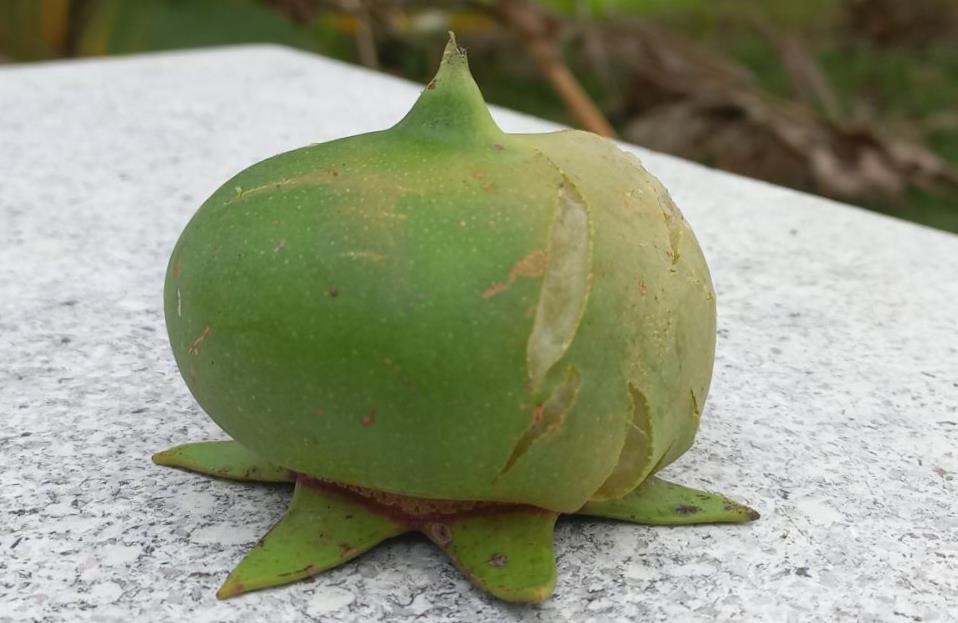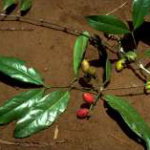Mangrove apples are the fruits of Sonneratia sp. trees, one of the important genera of trees in the Mangrove forests of Southeast Asia. All species of Sonneratia will develop edible Mangrove apples. The various Sonneratia species differ slightly in shape, orientation of calyx leaves, and direction of style (long, slender stalk in female flowers).

Description of Sonneratia sp.
For this article, I took pictures of trees and fruits of Sonneratia caseolaris, which, together with S. alba, is the most widely distributed Sonneratia species from Eastern Africa via Southeast Asia to Micronesia. See the distribution map below.

Sonneratia trees grow directly at the edge of brackish water in marine environments. People on the water’s edge often plant them to stabilize the riverbanks. Botanically, Sonneratias are fascinating plants, as they utilize ultrafiltration to prevent salt overload in their system. They extrude salt via their leaves. It was even suggested that they deposit salt in their leaves, which will be shed when no longer required. Plus, their roots are pneumatophores for breathing oxygen and stabilizing the plant structure.



Mangrove apples will flower from October to December, and the fruits will be ripe for harvesting from November to March. For further description of the plant, see here.
Use of ripe fruits
Mangrove apples can be eaten raw, processed, or cooked in juices, jams, and dishes. Ripe fruits will fall from the tree and are often cracked.

The whitish translucent meat inside ripe fruits is mushy and has a strong, characteristic smell of fermented fruit. Our dog liked it so much that he repeatedly rolled in this gooey pulp. Due to the difficulty of separating the seeds from the meat, the fruit is often processed into fruit juice, and the seeds are strained.

Mangrove apple flowers and fruits are processed into rustic dishes in the Mekong Delta region. Its flowers are used for pork- or seafood salads, considered a specialty in Cù Lao Dung district in Sóc Trăng province in the Mekong Delta of Vietnam.

Ripe mangrove apple fruits are used for sour soups and hot pots. The mushy content is cooked with fish, cabbage, coriander, or other ingredients. These soups and hot pots are said to effectively reduce summer heat.
Mangrove apple juices and jams are also commercially available in Vietnam for additions to such sour hot pots or as tips for boiled meat. For another application, I was informed that coastal people in the Philippines ferment mangrove apples into vinegar.
Nutritional content of ripe fruits

The nutritional contents of fresh, ripe Mangrove apples are as follows:
- 84.76% water (NW, which is Net weight),
- 8.40% ash content (GW, which is Gross weight),
- 4.81% fat (GW),
- 9.21% protein (GW), and
- 77.57% carbohydrate (GW)
- The fruit yields 11% pectin ZMB (Zero-Moisture Basis)
- Vitamin A 221.97 IU
- Vitamin B 5.04 mg/100g
- Vitamin B2 7.65 mg/100g
- Vitamin C 56.74 mg/100g
- Ascorbic acid 40 mg/100 g,
- Beta-carotene 9.96 mg/100 mg
- Tannins 22.65%
Therefore, the fruits have a high nutritional and antioxidant content.
Use of unripe fruits


Unripe Mangrove apples have firm flesh and a real sour taste. They are riddled with angular-shaped tiny seeds. Due to the sour flavor, snippets of Mangrove apples are often used as a flavorizer for chutneys, curries, or stews. Sour mangrove apple fruits are also used as raw vegetables, served with shrimp sauce. The sour and acrid flavor and the strong taste of fish sauce create a typical flavor that cannot be found in other fruits. When eating raw, dipping the chips of fresh Mangrove apples into salt will lessen the sour taste.
The following short video clip shows my first taste of the Mekong apple.
In Vietnam, the wood of Sonneratia breathing roots is used as a swimmer for fishing lines and nets. The wood density is only around 0.37 g/cm3 / 23 lb./ft3. For comparison, Spruce wood is around 0.45 g/cm3 / 28 lb./ft3 or higher.
Lessons learned about Mangrove apples
- Sonneratia trees are one of Southeast Asia’s main constituents of mangrove forests.
- The local population likes to plant them along brackwater edges for bank reinforcement.
- The article above explains that mangrove apples can be eaten raw or processed in various ways.
.




